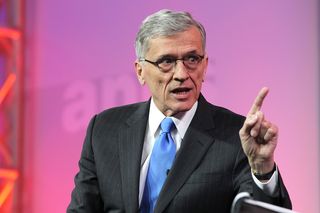Wheeler: Internet Has Performed Brilliantly

Former FCC chairman Tom Wheeler says that the current health crisis as exposed both the brilliance of the Internet's architecture, but also the pressing need to get that network to all Americans.
Wheeler was praising ISPs last week for keeping the internet up and running during the crush of COVID-19 coronavirus-related traffic, a critical service he suggested must now be considered a necessity for all Americans.
In an online post, "Why the Internet Didn't Break," for the Brookings Institution, where he is a visiting fellow, Wheeler gave credit to the nation's broadband providers. "The fact we can work from home is the result of hundreds of billions of investment dollars and construction and operational skill."
Wheeler is also the former head of NCTA-The Internet & Television Association and CTIA-The Wireless Association, both key players in that all-important buildout.
Wheeler spent much of his FCC tenure calling out ISPs for being the potential choke points in an open internet, and his FCC eventually imposed regulations on access that the current FCC scrapped.
But his Brookings post was not focused on ISP business practices, but on the architecture of the internet that allowed it to handle the new traffic load including the fact that it was built with the operationally flexibility to handle traffic surges and that its architecture is an interconnection of nets, a system he says has worked brilliantly during the present crisis.
But when it came to the politics of the issue, Wheeler was on familiar ground. He said where the internet WAS broken was the digital divide, where at least 20 million-plus people didn't have access to broadband and likely more because the FCC numbers were "notoriously suspect."
Multichannel Newsletter
The smarter way to stay on top of the multichannel video marketplace. Sign up below.
The Wheeler FCC, in its annual assessments of broadband buildouts, consistently concluded it was not being deployed to all Americans in a timely fashion, basically because it had not been deployed to all Americans.
In the Brookings piece, Wheeler also said for millions more people broadband was too expensive, taking a shot at the recent CARES Act allocation of $125 million for rural telecom loans because those loans did not require the networks getting the money to meet "minimum" thresholds for high-speed service.
The bill defines high-speed as 10 Mbps download, 1 upload. In its home broadband guide, the FCC advises that for two people or devices using the Internet, even moderate use--basic functions like email, browsing, basic video, VoIP, Internet radio plus one high-demand application like video streaming, online gaming, or telecommuting--needs 12-25 Mbps, and if more than two, 25 Mbps-plus.
Related: CARES Act Buttresses Rural Broadband Funding
Wheeler pointed to the Lifeline broadband subsidy program when talking about price as a barrier, saying "the Trump FCC has cut back the number of companies that can participate in the program, making it harder for those who need the service."
Given the current crush of telework and telemedicine and distance learning in addition to all that high-def binge watching, Wheeler says, the Internet is now indisputably a necessity for all:
"Three weeks ago, everyone’s point of reference for high-speed broadband networks was the one-way delivery of video services such as Netflix. Henceforth, broadband will be recognized for what it is: a critical two-way connection that can no longer be considered a luxury."
Contributing editor John Eggerton has been an editor and/or writer on media regulation, legislation and policy for over four decades, including covering the FCC, FTC, Congress, the major media trade associations, and the federal courts. In addition to Multichannel News and Broadcasting + Cable, his work has appeared in Radio World, TV Technology, TV Fax, This Week in Consumer Electronics, Variety and the Encyclopedia Britannica.

